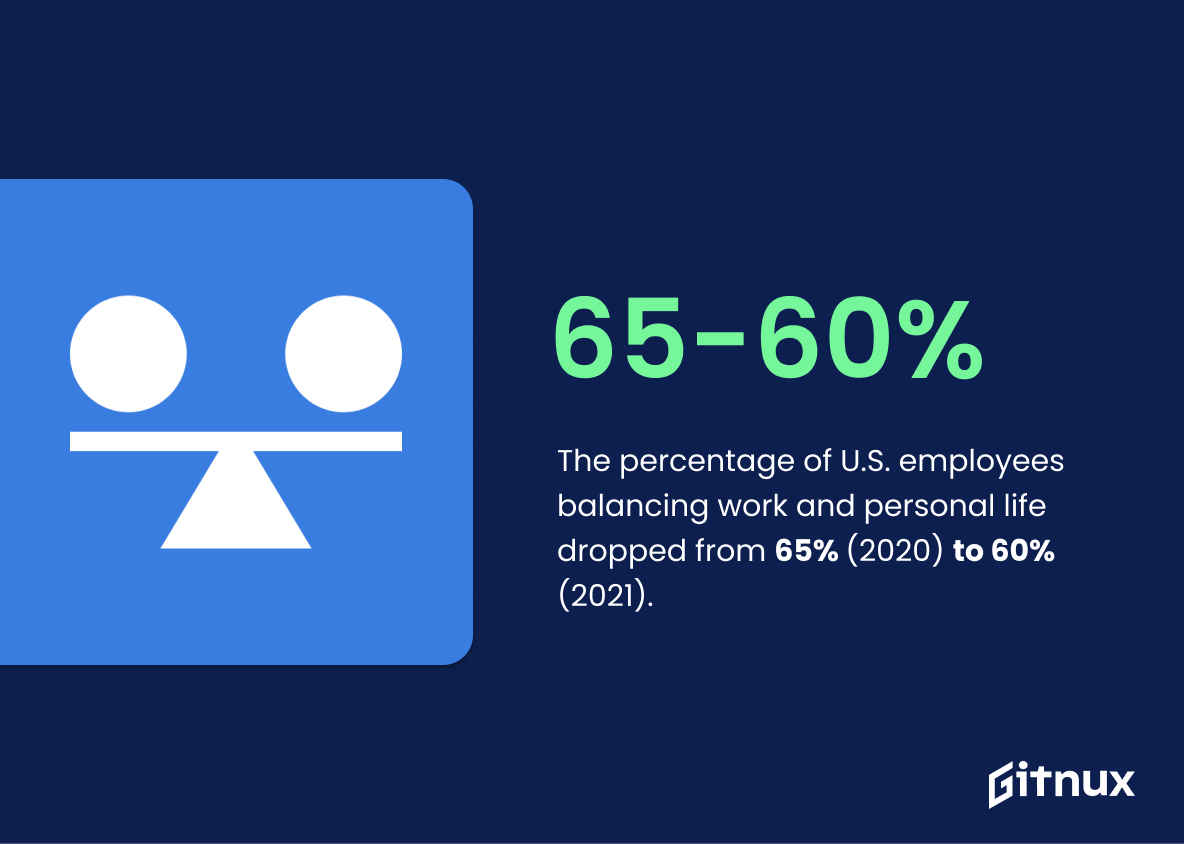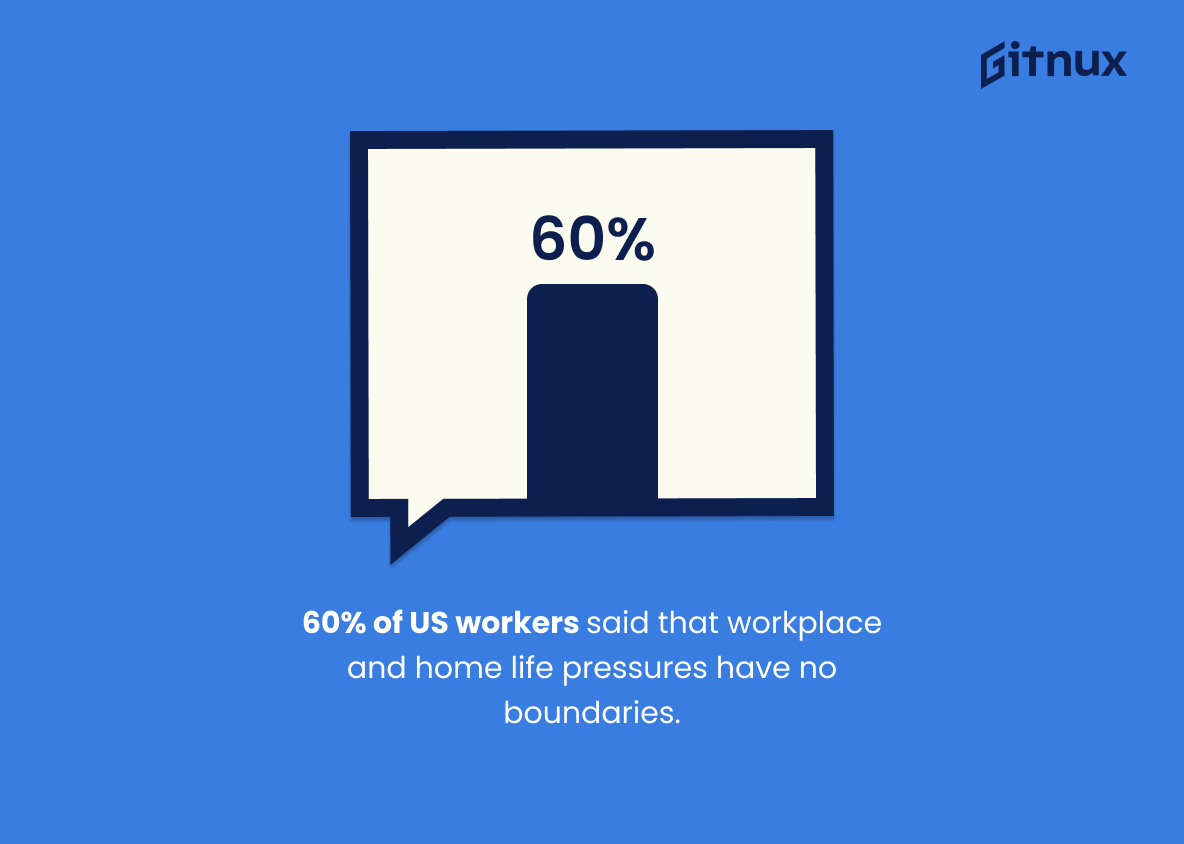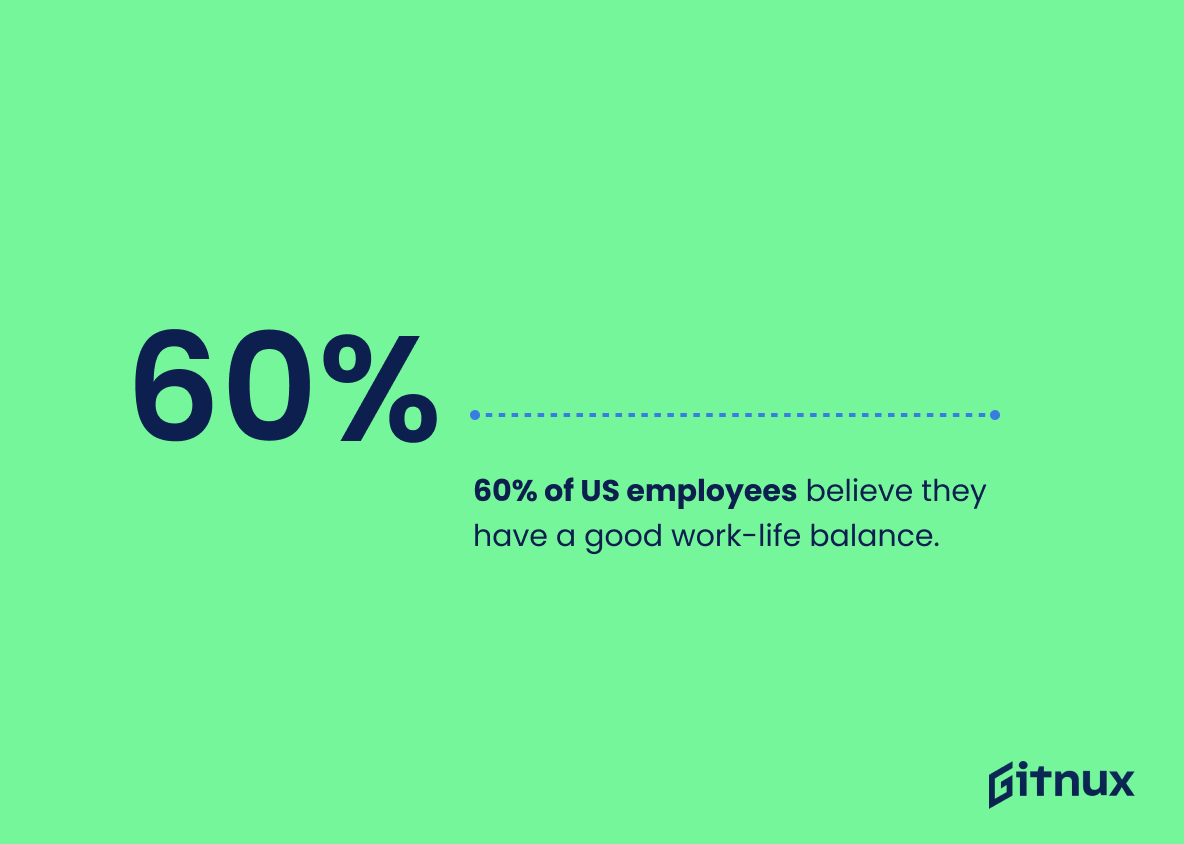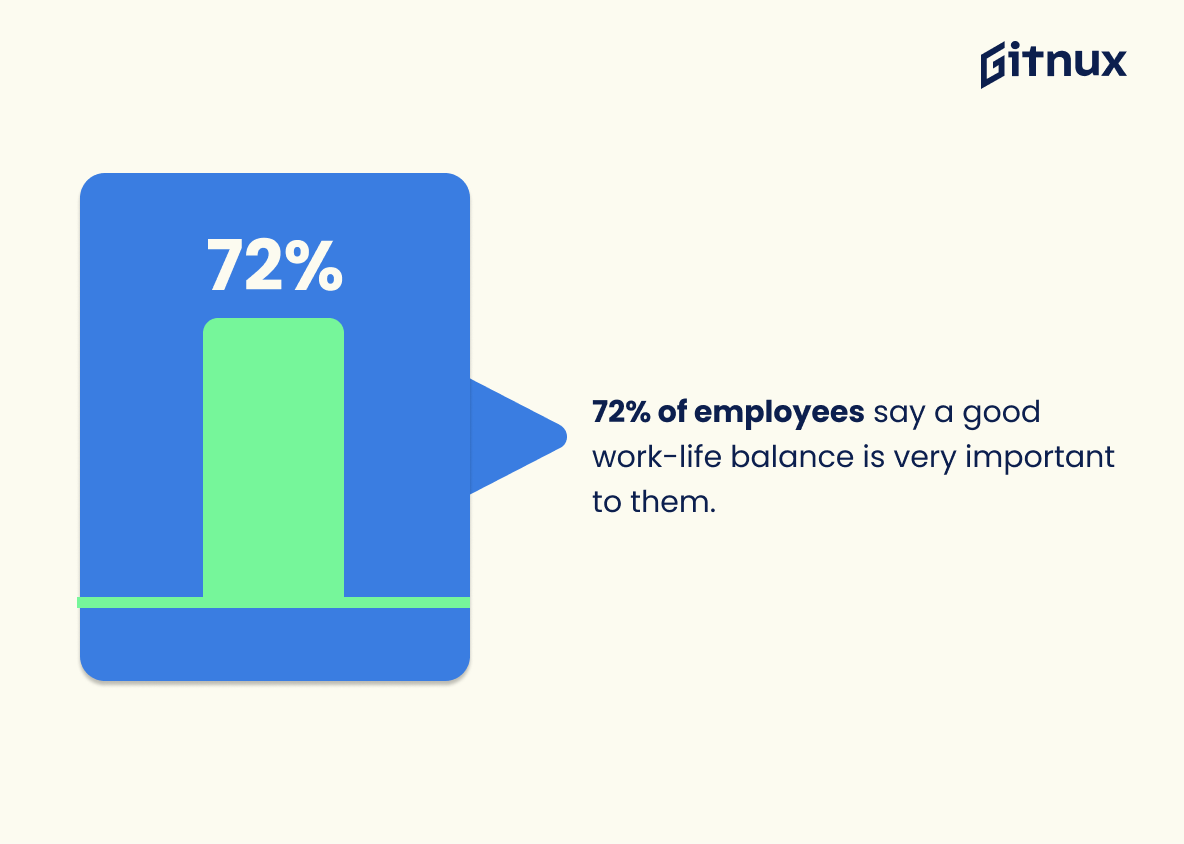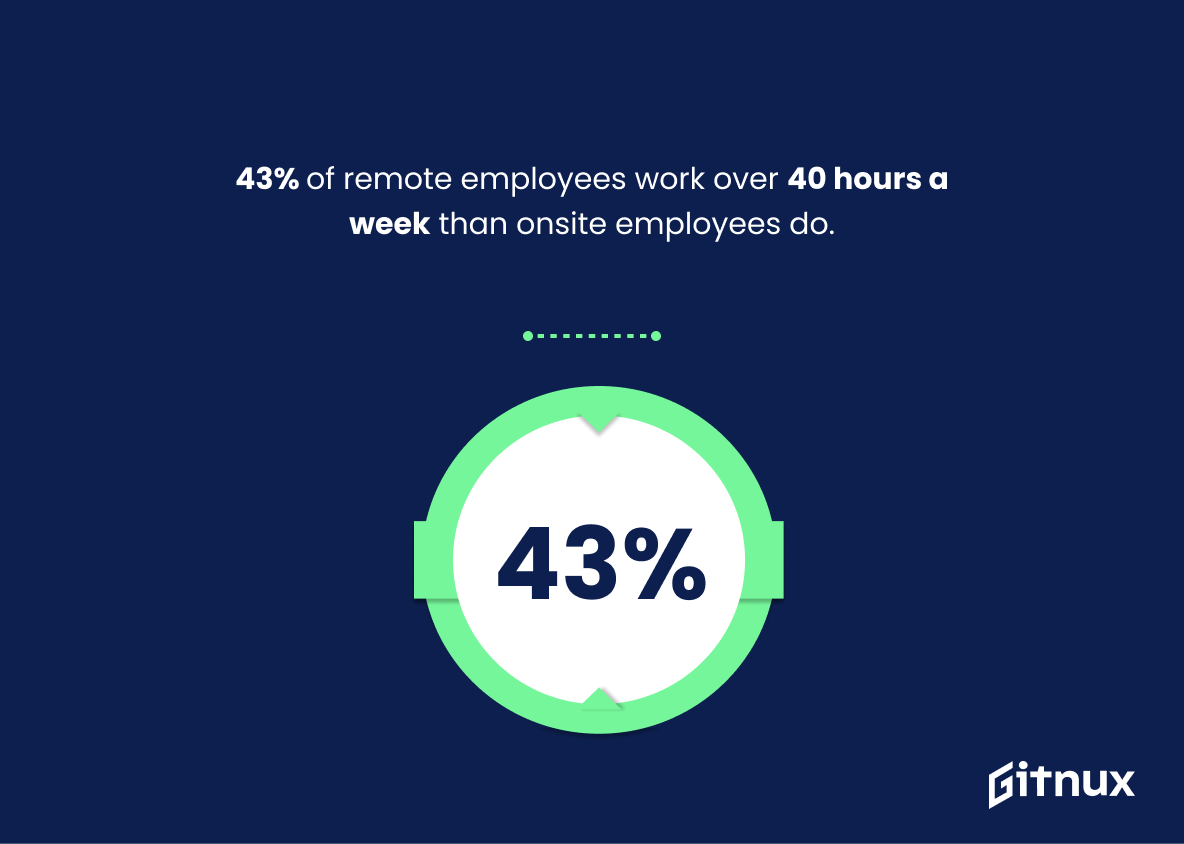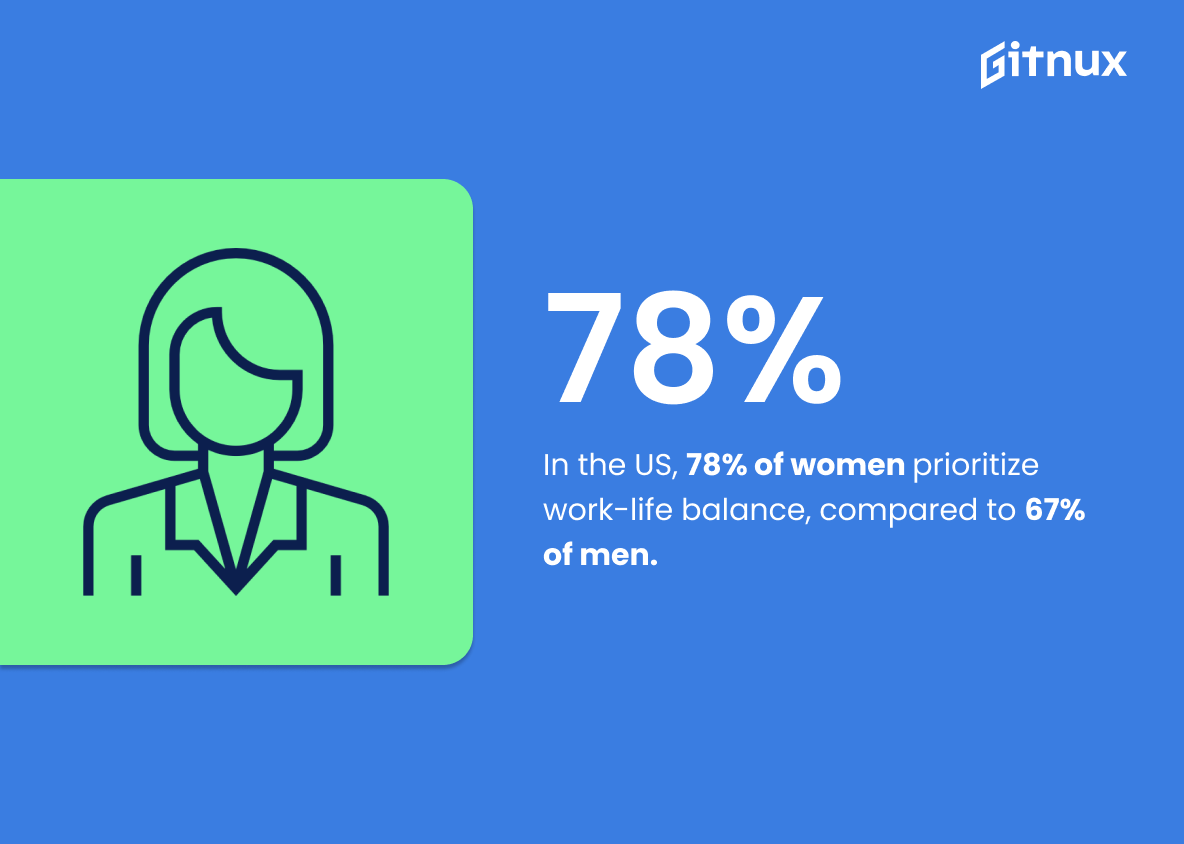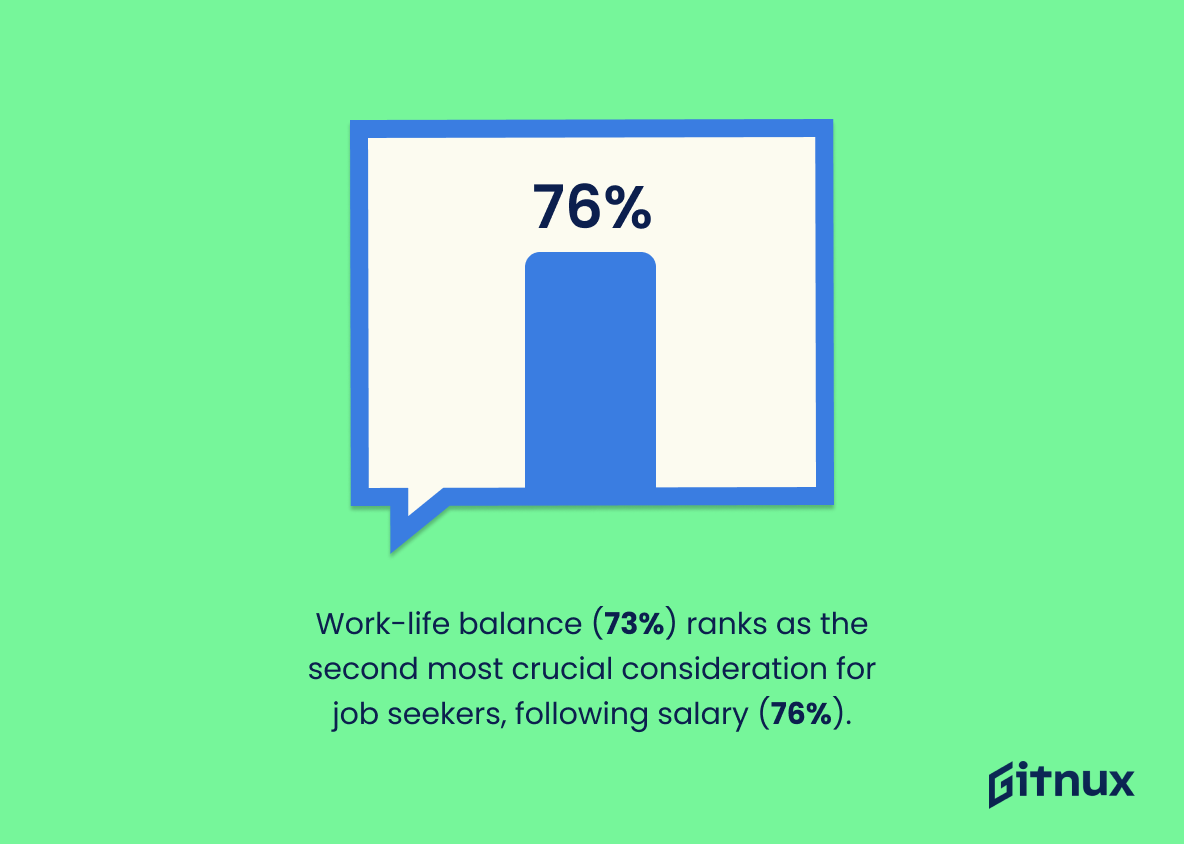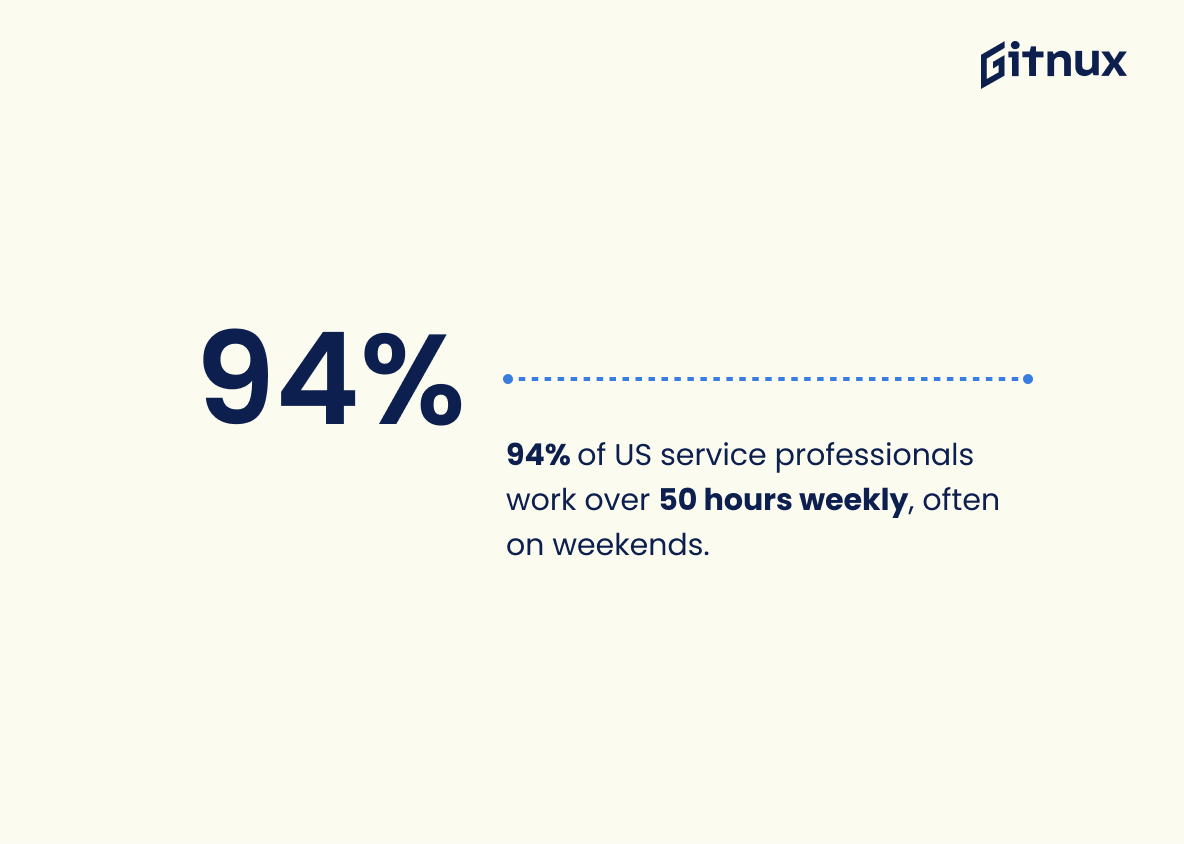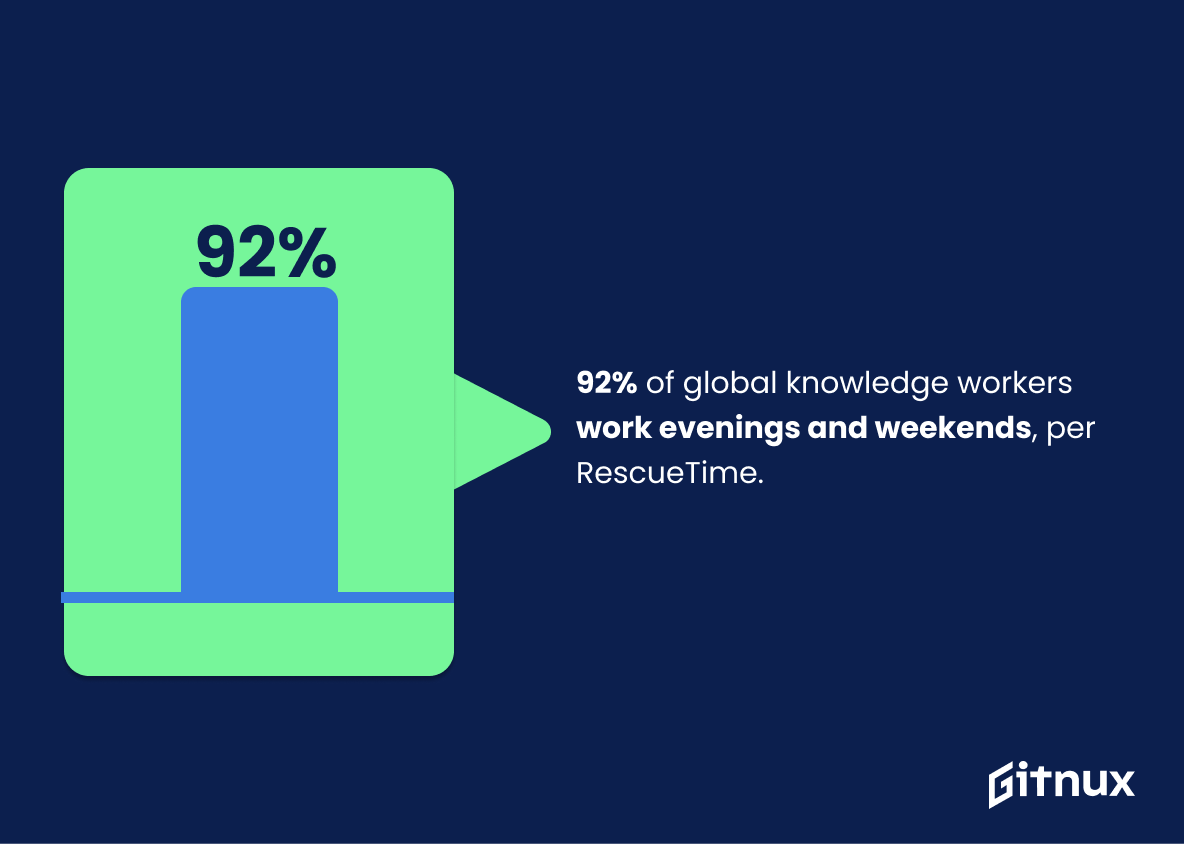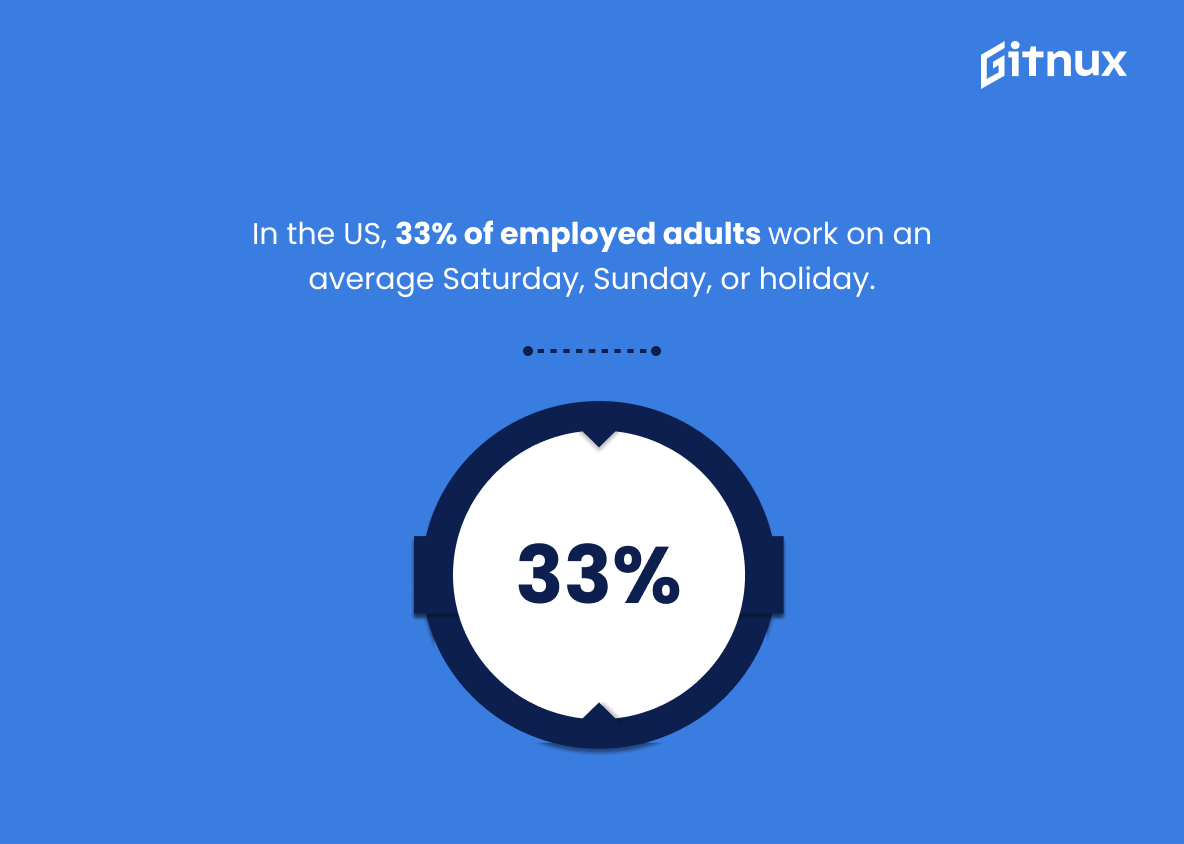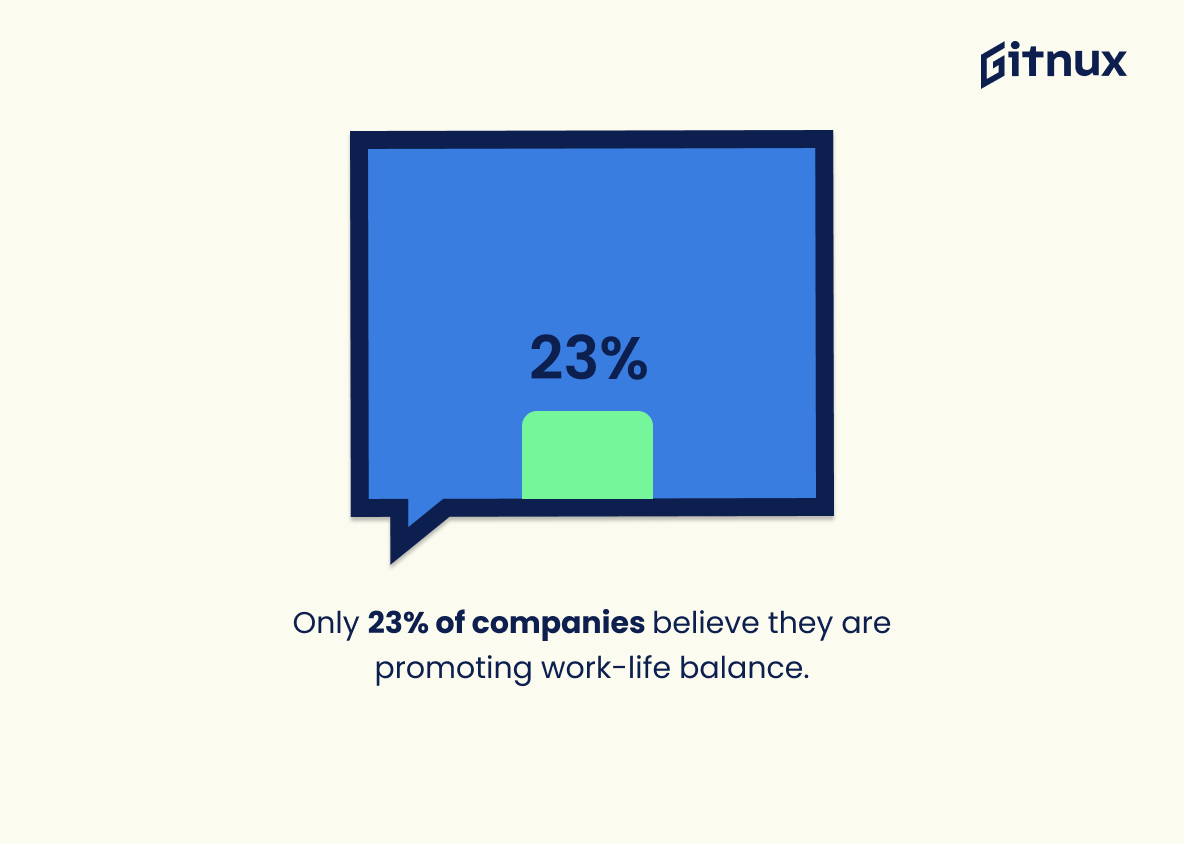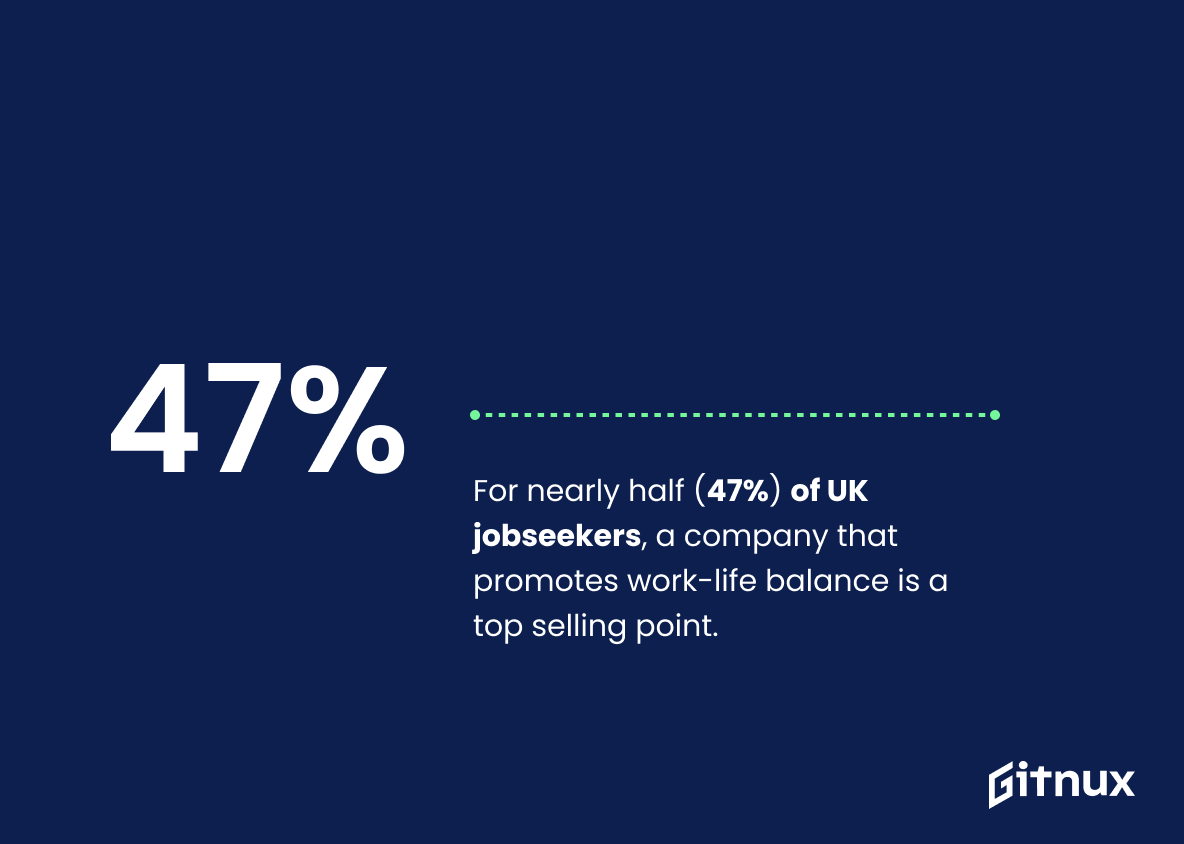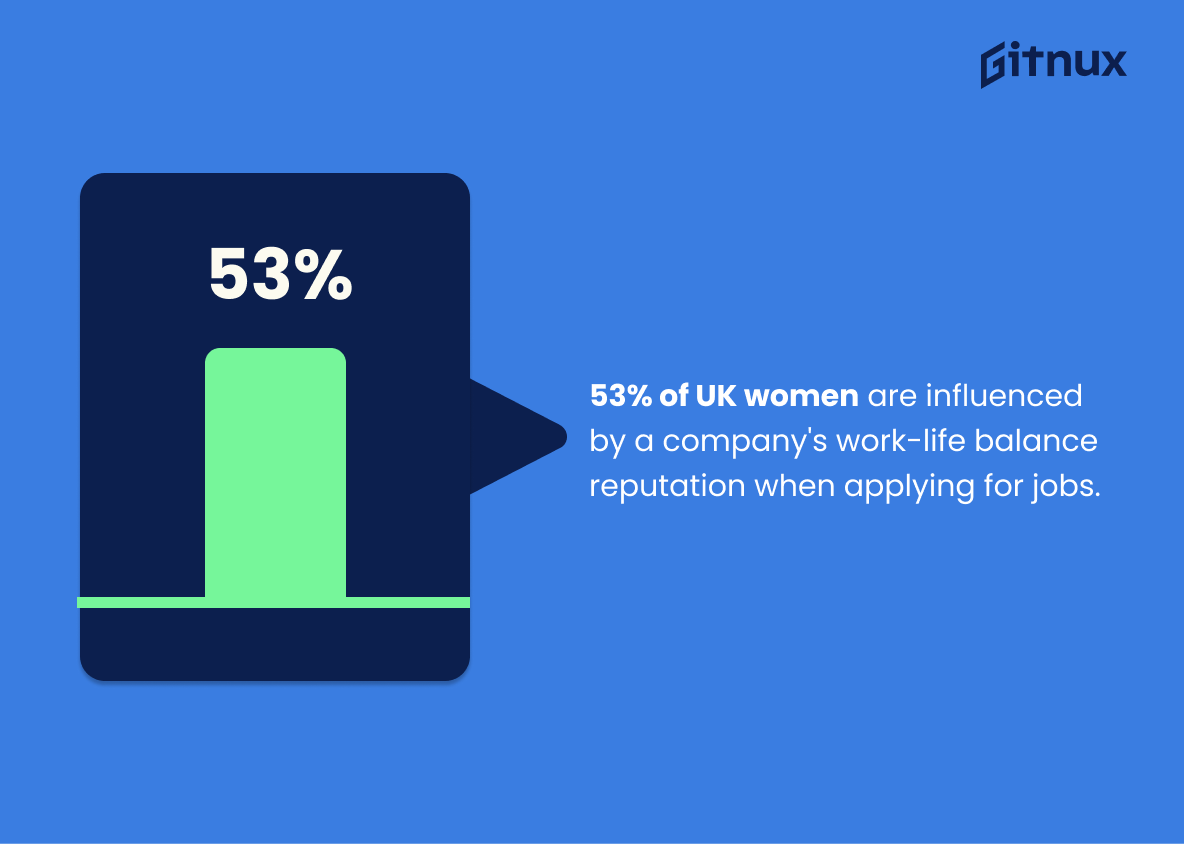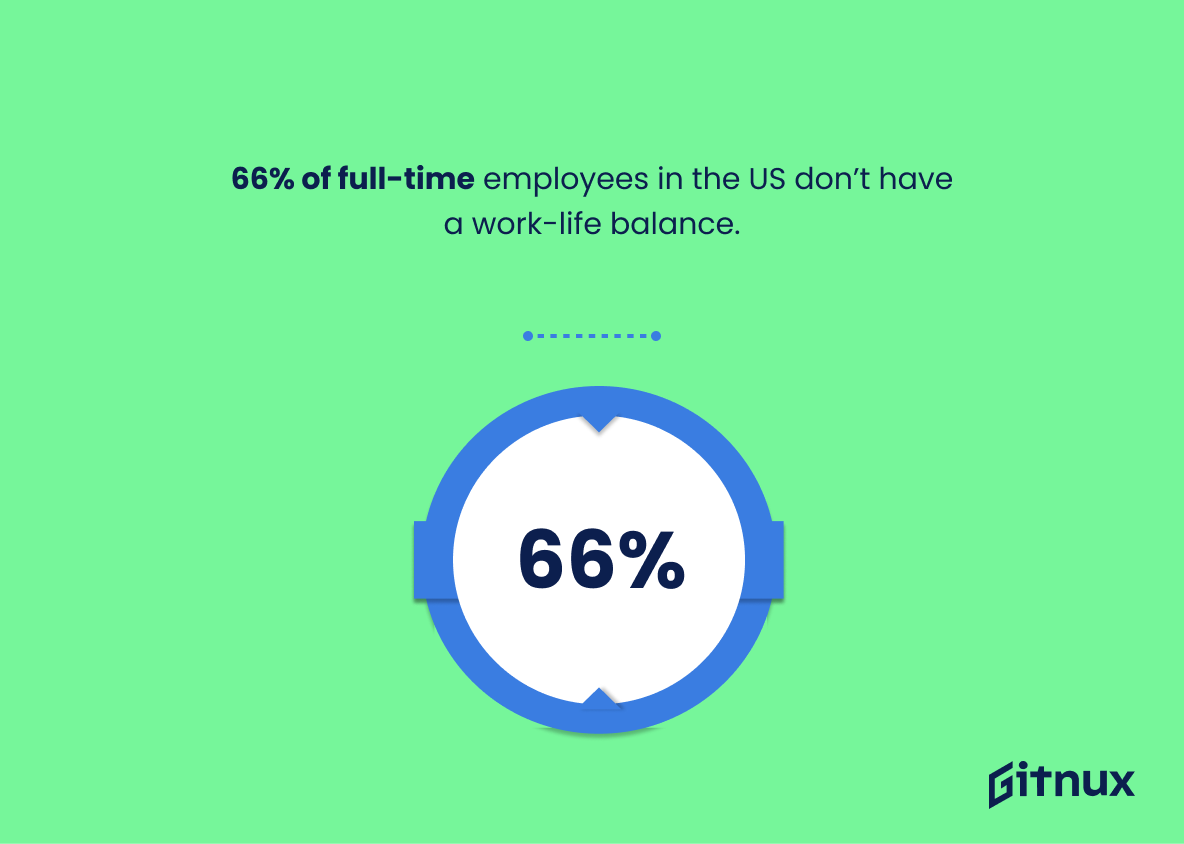Modern working life can be incredibly demanding, and it’s crucial to have a good balance between personal and professional aspects of life. Numerous people around the world struggle to find time for themselves and juggle the responsibilities of work, home, and leisure.
Finding a healthy work-life balance gets more and more challenging in our new digital era, and it is important to understand the most recent trends on this topic if you want to achieve it. In this article, you will see the latest work-life balance statistics for a better overview of the present situation.
Work-Life Balance: The Most Important Statistics
In the US, 33% of employed adults work on an average Saturday, Sunday, or holiday. This has led
66% of full-time employees to say they don’t strongly believe they have a work-life balance.
Only 23% of companies believe they are promoting work-life balance.
General work-life balance statistics
The percentage of U.S. employees who were effectively able to balance/manage their work and personal life commitments decreased from 65% in 2020 to 60% in 2021.
60% of US workers indicated that the pressures and responsibilities of the workplace and home life don’t have boundaries.
60% of US employees believe they have a good work-life balance.
72% of employees say a good work-life balance is very important to them. In contrast, only 6% of those surveyed said that a work-life balance was not very important, not important at all, or that they had no opinion on it. 57% of surveyed employees say a poor work-life balance is a deal-breaker when considering a job.
43% of remote employees work over 40 hours a week than onsite employees do.
In the US, 78% of women think that picking a career based on work-life balance is essential, compared to 67% of men.
FlexJobs surveyed more than 8,000 professionals and found that many desire a flexible job to help them reduce stress, improve their health, and have a better quality of life. Work-life balance (73% of respondents) is the second most important “perk” workers look for and analyze when evaluating a job offer, after salary (76%).
94% of the US workers in the professional service industry work over 50 hours a week, while many of these people work on the weekends. 48% of Americans consider themselves to be workaholics.
According to a RescueTime survey, 92% of knowledge workers from around the globe say they regularly work in the evenings and on weekends. Employees also have communication overload. 34% of people check their email as soon as they wake up. While another 47% do so within the first 30 minutes of work.
In the US, 33% of employed adults work on an average Saturday, Sunday, or holiday. This has led 66% of full-time employees to say they don’t strongly believe they have a work-life balance.
Workers think that employers and governments can increase work-life balance by offering flexible hours (69%), allowing remote working (55%), offering unlimited paid time off (27%), restricting email responses, e.g., can only respond 9-5 (27%), establishing meeting-free blocks of time (24%).
If you are eager to learn more about more efficient meetings, check out our detailed meeting guide.
Only 23% of companies believe they are promoting work-life balance. More companies need to promote work-life balance by setting up arrangements that are employee-friendly.
Joining a company that encourages good work-life balance is one of the top-selling points for nearly half (47%) of jobseekers in the UK.
53% of surveyed women in the UK say that a company’s reputation for offering a good work-life balance would make them more likely to apply for a job, while only 42% of men would be attracted by this perk.
66% of full-time employees in the US don’t have a work-life balance.
About 82% of American companies are already using flexible work locations to improve the work-life balance of their employees.
An astonishing 84% of freelancers are happy with their lifestyle.
Benefits of a healthy work-life balance
Perceived benefits to employees in remote work setups in Europe in 2020 were working with a pet by side (28%) and more time with children (26%).
Around 21% of workers with good work-life balance tend to work harder.
Companies with employees who benefit from a good work-life balance report that their healthcare expenditure is 50% lower.
91% of employees surveyed by Zippia decided to work remotely because they wanted a better work-life balance. 89% of surveyed HR professionals saw an increase in employee retention after implementing flexible work policies.
33% of employees who enjoy work-life balance benefits plan to stay in their current companies.
90% of employees say that a flexible work schedule would increase morale.
Giving employees the freedom to adjust their work schedules to the rest of their responsibilities makes for happier employees, and happier employees typically mean increased productivity and less turnover.
Companies that offer better work-life balance have a 25% lower employee turnover. Furthermore, 24% of employees who enjoy some form of work-life balance program, such as working from home at least once a month, are significantly more happy and productive.
Additionally, 85% of businesses that provide work-life balance opportunities report that they are more productive.
73% of surveyed workers said that they had a better work-life balance thanks to working at home. The additional balance gave them more time with their family/children (46%), more time with their partner (42%), and the ability to take care of their pets (37%).
The main drawbacks of poor work-life balance
Spending more than 55 hours a week at work increases the risk of anxiety and depression.
60% of employees blame their bosses for work-life imbalance.
Sadly, the top consequence of poor work-life balance was the suffering of family relationships, reported by nearly 48.8% of respondents. Individuals also cited a loss in their relationships with their friends and themselves (47%) and gaps in their physical, emotional and spiritual health (37.8%).
2 in 5 employees say that a bad work-life balance ruins the time that is spent with family and friends.
60% of employees believe bad bosses can have the most negative impact on work-life balance.
In 2021, 35.7% of surveyed US employees stated that troubles balancing work with personal obligations (e.g. childcare, etc.) added to their work-related stress.
While personal perfectionism is the biggest barrier to a good work-life balance, 67.2% of workers report that some aspect of their work, colleagues, or corporate culture is the biggest culprit behind poor work-life balance.
32.8% of surveyed workers say that personal perfectionism is the biggest impediment when seeking a healthy work-life balance. 24.2% of respondents say company culture made it difficult to balance their personal and professional lives.
13.8% chalk up poor work-life balances to work itself, 13.2% to their bosses and supervisors, and 16% to burnout. 31% of employees, surveyed by Zippia, say that a lack of support or recognition from their leaders was the biggest driver of their burnout.
Over 25% of employees who felt they had no support from their employers in maintaining a healthy work-life balance planned to find a different job within two years.
This is important for companies to note because, on average, employee turnover costs the organization 21% of the employee’s salary.
Unscheduled sick and vacation days cost companies between 2,600 USD and 3,600 USD per employee per year. Employees who say they have high stress levels spend almost 50% more on healthcare costs than those who aren’t under so much strain.
Stressed employees get sick more often, leading to more unanticipated employee absences among those who have poor work-life balances, which, in turn, leads to more expenses and less productivity for their employers.
Out of 1,000 respondents on a work-life balance survey in the US, 77% of employees who work full-time have experienced burnout at their jobs.
65% of employees report that workplace stress has caused various difficulties in their lives. Additionally, about 10% say that workplace stress has caused major issues in their personal lives.
83% of workers say their personal relationships are negatively impacted by burnout from work.
This, combined with the fact that 25% of employees never or rarely take days off of work, means that a significant number of employees are missing out on meaningful time and connection with their loved ones because of their jobs.
More than 50% of employees think technology has ruined the modern family dinner.
Work-life balance in different countries
Work-family conflict is much higher in the United States than elsewhere in the developed world. One reason is that Americans work longer hours than workers in most other developed countries.
People in Italy enjoy the best work-life balance, according to recent findings by the OECD. Unsurprisingly, the most important aspects of a healthy work-life balance are the amount of time people spend (not) at work, how many people work very long hours and how much time remains for leisure.
Employed Italians had the most time for leisure and personal activities, according to the survey, while only 3% of workers in the nation put in more than 50 hours every week. In comparison, 10.4% of American employees worked very long hours, causing the United States to rank much lower (29th out of 41 countries in the running).
According to the OECD, Mexicans are among those who struggle the most with finding a work-life balance.
The lives of Costa Ricans and Colombians aren’t exactly balanced, either.
In the 2020 Better Life Index, which included all 38 OECD member nations (plus Russia, Brazil, and South Africa), the US and the UK did not fare much better, placing 13th and 14th, respectively.
Less than half of those polled in a New Zealand survey in 2022 said they had an excellent or good work-life balance. About 15% of participants believed they had a bad or extremely poor work-life balance.
58% of Singaporean higher education students and graduates said they anticipate balancing their work and personal lives in their first employment.
According to the same survey, 41.8% of respondents intend to stay away from demanding jobs.
In India, over 37% of female professionals said they wished to leave their current position because of India’s poor work-life balance.
However, due to the unsatisfactory work-life balance in the nation, only approximately 28% of the male respondents were likely to resign.
A survey was conducted among Chinese fathers on their solutions to balancing work and family. Around 44% of respondents stated that in order to provide better financial security for their kids, they had to sometimes sacrifice time with them.
More men than women in Russia think that they spend more time on work than on their private life. Slightly over 50% of female respondents believed they maintained a work-life balance.
40% of people in Russia above 45 years prioritize work over private life. To compare, 25% of 18-to-24-year-old Russians felt like they spent more time on work.
Our article about Night Shift Statistics can also be of interest for you
Conclusion
The statistics show us that having a good work-life balance is something that many people prioritize. Some are even ready to quit their jobs and search for new ones with a better work-life balance system in place.
The latest numbers also show that unfortunately lots of companies don’t take it seriously enough. Organizations need to make sure their employees are given the opportunity to have a healthy work-life balance. It is crucial not only for the employees but will also benefit the company itself because as we all know, happier employees are better employees!
References:
Statista: “Percentage of U.S. employees who had select attitudes about work in 2020 and 2021”, cited in January 2023 (Source)
Ehstoday: “More Than Half of Americans Have Unhealthy Work-Life Balance”, cited in January 2023 (Source)
Zippia: “20+ vital work-life balance statistics [2023]: the difficult importance of maintaining it”, cited in January 2023 (Source)
Statista: “Importance of work-life balance among employees in the U.S. in 2018, by gender”, cited in January 2023 (Source)
Flexjobs: “FlexJobs Survey: Why Flexible Work Should Matter to Employers”, cited in January 2023 (Source)
Apollotechnical: “0 statistics on work-life balance that may surprise you”, cited in January 2023 (Source)
Rescuetime: “The 9–5 workday is dead: New research shows 92% of people work on evenings and weekends (even before the pandemic)””, cited in January 2023 (Source)
Smallbiztrends: “The Stats on the Work-Life Balance of Your Employees (INFOGRAPHIC)”, cited in January 2023 (Source)
Deloitte: “The employee experience: Culture, engagement, and beyond”, cited in January 2023 (Source)
Glassdoor: “Glassdoor Study Reveals What Candidates Look for in Job Ads”, cited in January 2023 (Source)
Teamstage: “Work-Life Balance Stats: Is There a Cost to Work Promotion in 2022?” , cited in January 2023 (Source)
Comparecamp: “79 work-life balance statistics: 2020/2021 current state & industry practices”, cited in January 2023 (Source)
Statista: “Perceived benefits to employees in remote work setups in Europe in 2020″, cited in January 2023 (Source)
Flexjobs: “FlexJobs Survey: Productivity, Work-Life Balance Improves During Pandemic”, cited in January 2023 (Source)
Grand Canyon University: “Work-Life Balance Stats Among Business Professionals”, cited in January 2023 (Source)
Adobe:“The Work-Life Imbalance Report”, cited in January 2023 (Source)
Apollotechnical: “10 statistics on work-life balance that may surprise you”, cited in January 2023 (Source)
The Center for American Progress: “The Three Faces of Work-Family Conflict”, cited in January 2023 (Source)
Statista: “Level of satisfaction with work-life balance in New Zealand in 2022”, cited in January 2023 (Source)
Statista: “Likelihood of quitting job due to poor work-life balance in India as of December 2021, by gender”, cited in January 2023 (Source)
Statista: “Fathers’ solutions to balancing work and family in China as of June 2019”, cited in January 2023 (Source)
Statista: “Do you think you manage to keep a balance between work and private life?”, cited in January 2023 (Source)
ZipDo, cited June 2023: Work Life Balance Statistics
